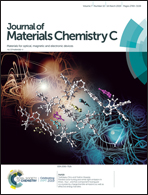Lanthanide cation encapsulated in a metal–organic framework as a white LED and selective naked-eye reversible HCl sensor†
Abstract
In this article, anionic HPU-14 with permanent porosity and excellent stability in air was used as a platform for loading green-emitting Tb3+ and red-emitting Eu3+ into nanotube channels of a blue-emitting metal–organic framework via an ion-exchange process. The emissions of HPU-14@Tb3+@Eu3+ were in the white region with a high quantum yield of up to 7.1% when this composite was excited at 365 nm (X = 0.325, 0.315). HPU-14@Tb3+@Eu3+ was suitable for a white light-emitting device and enabled the sensitive colorimetric reversible detection of gaseous HCl while the host net remained intact.



 Please wait while we load your content...
Please wait while we load your content...